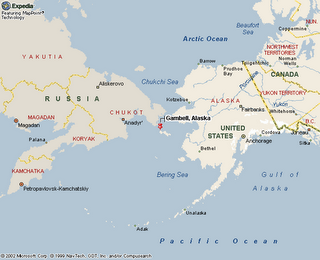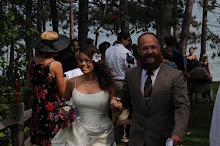Carrie and Core's Adventure in Sivuqaq
Welcome to Carrie and Core's adventure in Sivuqaq. Sivuqaq "wrung out dry"is the Siberian Yupuk name for St.Lawrence Island. We live in Gambell, on the Northwest cape of Sivuqaq just 35 miles east of Siberia. I hope you enjoy the posts, pictures and comments feeL free to post us a little note. PLease...please...please!
Saturday, June 01, 2013
Sunday, April 29, 2007
Monday, April 23, 2007
Destination: Seal Camp

This grouping of three buildings is similar to many of the hunting camps scattered along the coasts of St. Lawrence Island. This site is primarly used in the fall to hunt ice seals that come in with the wind. These shacks are nothing fancy, but like everything Eskimo, they are very practical and comfortable. The building we chose in this pitcure was well insulated with wind- blown snow as you can see. Like most of the shacks out here, the building has an attached breezeway that fills with snow in the winter. This serves to further insulate the building much like breezeway in an igloo. Inside you'll find a standard 55-gallon drum cut in half that serves as the stove. It got the place warm in a hurry despite a continual 20-30 mile wind on the outside.
Tracks Leading From the Sea

Jeff and continued to travel south from the crash site looking for the next seal camp on the coast. On our way, we ran into these recent polar bear tracks that, because of the effects of the wind, had eroded into what appeared to be three dimensional, almost inverted casts of the bear's feet. This spectcaular effect cast an errie pale over the rest our trip as it became apparent that we would be sharing the tundra with the largest land carnivore on earth, an animal that is a strict carnivore and was here for the same reason the Eskimos come here; seal meat. These particular tracks literally come right off the sea ice disappearing west onto the tundra. Our camp was a mere 300 yards to the south of these tracks. I had the foresight to bring along spray but considering the wind conditions out here, I figured we'd have a one in four chance of spraying with the wind depending on the drection of a charge.
Winter Camping

Even though May is almost here, the island is still in the midst of a solid winter out here. Jeff and I decided to revisit the seal hunting camp that is pictured towards the beginning of this blog. That pitcutre was taken last September and it was great to come back on the tundra when it was solid. We loaded up another teacher's 4-wheeler and left on a sunny Saturday afternoon expecting to camp out 8 miles south of the village at the shack. Unfortunatley, we discovered that after getting all of the way out there, one corner of the shack had a big hole burned in it. The place was filled with 4 feet of snow and obviously uninhabitable . We'd heard of a another camp about 3 miles further south along the coast so we decided to press on. It was the best impromptu camping decision I'd ever made. On the way to our new location, we came across the remains of true Cold War relic. In June of 1955, a Lockeed Pv-2 Neptune with 11 Navy airmen onaboard was shot down while on a reconnassaince mission near the international dateline some twenty miles west of here. The nearest runway was in Gambell so the crew struggled to make it there falling short here in the tundra. All of the crew survived thanks to the quick efforts of the Gambell Army National Gaurd. The following picture details the tail boom of the big twin engine airplane.
Note the burned out hole on the corner of the shack.
Wednesday, April 11, 2007
A Lost Bet

In December of last year, I made a bet with one of my students who has lived in Gambell all his life. Fifteen year-old Ala Apassinggok told me I would see a polar bear sometime in the near future here in Gambell.
Thinking this would be an easy bet, since very few people I know actually see the great Nanuuq out here, I bet him 20 bucks I wouldn't. Shortly after photograhing the image of the bear track posted here, I went home to grab some dinner and prepared to go back out and look for more tracks that evening. I was going to leave at 7pm to go back out to the dump but decided to make a call back home first. After the call, I headed out with camera in hand hoping to catch a few extra photos of those awesome prints on the pack-ice. As I approached a rise on the hill facing north, overlooking the dump and the pack-ice, I could see it ambling slowly out of the sea coming up the beach not ten yards from the site of the first bear earlier that day. Another Nanuuq! And not 60 yards away! I just stopped where I was, incredulous at the fact that I was actually seeing something I had long since bet against seeing! All I could do was stand there and watch thinking if I hadn't made that phone call, I would have left a half hour earlier putting me right in its path. No sooner had I caught a glimpse of him than three loud shots in quick sucession rang out sending him reeling up on his hind legs, spinning a 180 and falling to the ground. From both the east and west came two hunters on snow machines to close in on the wounded animal. One final shot and it was dead. I ran down to the kill and got the following picture withe rifles. In the attached image, the bear is being cleaned by Fred Kanningok as others look on in satisfaction. It was hard as a non-native not to sentimentalize this splendid animal, but then again I'm sure glad they were there when they were. The next morning in school I walked up to Ala Apassinggok and gave him a crisp, new twenty-dollar bill not saying anything at all. He laughed and said "You saw one?" Yep. And I hope the next one I see is in a Coke ad.
One Day in Gambell

Were it not for the following fortuitous events to have taken place in Gambell in what I thought would be just another average day at school, I'm not sure I couldn't have left here thinking "well, I just doesn't get any harrier than this". On a blizzardy Monday morning, April 9, school was just getting in session when word spread that a large polar bear had been shot at the dump at 9 am by local Kenneth Iwoorgin. I pretty much gave up on the idea of Gambell getting polar bears by March as the pack-ice slowly began receeding further north. As soon as school was out, I went to Iwoorgin's house which isn't far from teacher housing to see for myself what the all the fuss was about. No doubt, this was a big animal. It measured nine feet nine inches from tail to nose leading me to beleive I should be able to find some very impressive tracks to match. Getting directions from the hunter, I went north from teacher housing about 1/4 of a mile to the dump and found the bear's skinned carcass and picked up on a nice set of tracks heading north onto the pack ice. It was here I got this picture. It wouldn't be until later that evening however, that the course of this not so ordinary's day's events would reach a very harry conclusion for me! The tracks here measure about eight inches across on the bear's forepaw instep.
Whaling in Gambell

"Whaling, the most dramatic harvest of the year, calls upon the community to use traditional models of shared work and distribution, and each participant must contend with the tensions that surround caring for family and caring for community."
Carol Ann Zolles,
author of "Food, Faith and Family in a Yupik Waling Community".
Mungtuk

"Mungtuk", the Yupik word, is the dark of the whale you see in this picture. The boat capatin gave out generous shares of both Mungtuk and blubber to the whole village including the teachers. I received at least thirty pounds of meat and blubber and have been eating whale sandwiches, whale stew and even yes, whale pizza! I've got my groceries taken care of for the rest of my stay I guess.
Sunday, April 08, 2007
The First Whale in Two Years
On Tuesday, April 3, during a particularly tough week for the students who were undergoing national testing, the news came into the school that whaling captain Junior Kanooka and his boat sucessfully caught the first bowhead whale in Gambell in two years. When I first came here in August I was told that two years ago, Gambell mayor and three of his cousins perished in a storm in the Bering Sea one night in April while
taking in a whale. Since that tragedy in 2005, no whale had been taken. It was clear to me at this point that this community has suffered a serious setback to its subsistence morale. Afterall, the bowhead whale has been the foundation of Siberian Yupik identity since the first chapter in their long history here on the island. The ecitement in the community was palpable as students and staff alike were released early from school to run down to the west beach to meet the hunters and their catch. When I arrived I was overwhelmed at the transformation these people underwent. Their was a festival atmosphere to the gathering as the crew begin to butcher this 20-ton animal.
Monday, October 30, 2006
Looking West from Mt. Sivuqaq
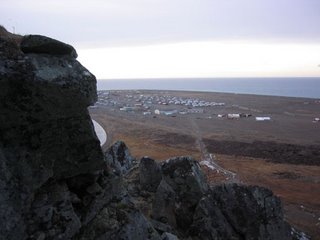
A view of Gambell from Mt. Sivuqaq really puts the village into perspective as a community perched upon the threshold of great sea. The seemingly flat, featureless surface really comprises an ever-shifting gravel spit spilling into the raw ocean where the depths drop dramatically at short distances giving way to a great continetnal shelf that was once the Bering Land Bridge. Walking the mile or so to school each day on the gravel is a big departure from navigating any improved surfaces and really helps the bush teacher out here earn the title "bush teacher".
Gambell: Centuries of Occupation
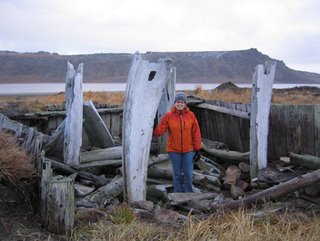
On the west beach, a few hundred yards from teacher's housing, lies the recently excavated remians a Siberian Yupik dwelling dating back to the late 19th century. This particular structure here with Carrie in the foreground was a style typical of the Nunglook or "underground" dwellings constructed from a whale bone frame and sod siding. The living quarters were were underground with the sod and bone srucuture above ground. The original occupation sites around Gambell predominate much of the west beach and were used largely as seasonal camps in the summer when fishing was good and the weather warm. It wasn't unitl the coming of the first missionary, Gambell's name-sake and it's first school teacher, Vene C. Gambell in 1898, that the present village was incorporated into a permanent year-around residence for the largely nomadic Yupik peoples here. By the mid-1920's, government- imposed laws made primary school mandatory for children through the age of 14, thus changing forever what was, for some 20 centuries, a nomadic, subsistence lifeway for the Siberian Yupik Eskimo. Without sentimentalizing too much, though, one should consider the fact that after a great epidemic in 1878-1879, the entire population of the island was reduced from roughly 3,000 people to as few as 150! It was within one decade of this great disaster that Alaska's territorial minister of education Sheldon Jackson sent its first reflief efforts into present-day Gambell to try and revive a shattered society. In 1891, the first herd of Siberian Reindeer were introduced to Gambell via Jackson as a way to provide the Yupik people a new more consistent harvest of game to replace falling harvests of bowhead whale and walrus. The irony here, not lost on my social studies students, is that the great edpidemic and declining harvests of traditional game that almost drove the Eskimo population of Sivuqaq into extinction was a direct result of overharvesting from American commercial whaling during the mid 1900's. It is also widely speculated that the mysterious epidemic was direct result of conatct and trade with these same American whalers.
Qughsatkut! King Polar Bear
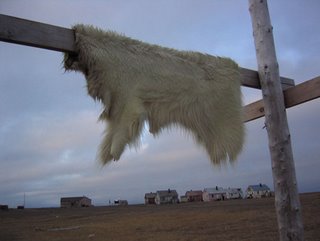
The namesake of our school and the subject of lively discussion with my first hour sophmores. Qughsatkut is "King Polar Bear" in Siberian Yupik and seems a fitting mascott for a community bound together with the ecosystem of the polar bear. At once elusive and opportunistic, "Nanuuk" as the animal is referred to in both Yupik and Inupiak (eskimo peoples further north) dialects, has frequented Gambell over the past few winters in significant numbers. Nanuuk is greatly revered here as a kind of "elder" hunter in kind who shares a carnivore's passion with the Siberian Yupik Eskimo for the several species of ice seal who make the Bering Straits their home. Thirteen Nanuuk were harvested last year in or around the village, and a mother and cubs were discovered making a curious but agressive foray into a residents front porch on the west beach. According to Junior Soonigruk, in my first period social studies calss, " Nanuuk comes with the first pack ice in December hungry for the ice (bearded) seal. You can can find him at the dump or in town when there's a big storm." Junior's implication, I think, was that Gabmbell, indeed the island of Sivuqaq, is a sort of way station for the hungry bear out on the Bering Sea ice pack ice. He may also have been trying to unnerve me in the face of a class of students eager to test the mettle of their new teachers. One thing's for sure: Junior knows what he's talking about. His father, Gerald Soonigook Sr., an experienced Nanuuk hunter is also the chairperson of one of thirteen chapters of the Alaska Nanuuk Commission, a native polar bear watchdog that provides regional/ local oversight of the annual polar bear harvest in accordance with both federal law and international treaties with Russia. Though the U.S. Fish and Wildlife Service impose no anual limit on the harvest of these animals, guidelines clearly stipualte that the hide and skull of each animal taken must be presented to conservation officials. The sale of Nanuuk's hide and claws are also strictly regualted within the village's boundaries. The Nanuuk hide pictured here was harvested last January along the north beach as one individual stayed a bit too long on the polar bear way-station that is Sivuqaq.
Sunday, October 29, 2006
Modern Life and Traditional Ways

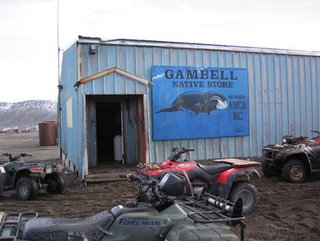

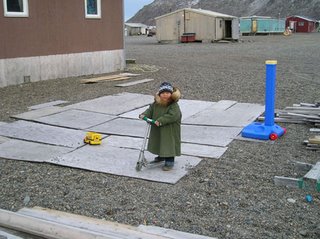
Because of its relative isolation from other regional hubs in Alaska (Sivuqaq is approximately 200 air miiles northwest of Nome) Gambell has maintained a degree of cultural autonomy and identity as a traditional subsistence community. Unlike many native communities in Alaska today, Gambell resident still speak their indigenous language Siberian Yupik and many of my current students still speak it in the community and at home. Gambell, however, does struggle with many issue related to influences from the outside world. The introduction of satellite technology in the 1980's and the increasing frequency of air travel and transport (there are currently three daily flights in arriving in Gambell from Nome from several air carries that provide supplies and transportation) have given residents the opportunity to suppliment their subsistence diet with store-bought goods as seen at one of the two general stores here in Gambell. Many elders speak of the loss of some traditional knowledge and an increasing reliance upon goods and services from the outside world. Most residents, however, find a balance between traditional and modern lifestyles. Seen here at the bingo hall, the Atuk, or Yupik dancing, is a bi-weekly community event in which elders call out the "old" stories to the beat of walrus gut drums while dancers act out in form. Dress is another important element of Yupik culture here as seen in this picutre of a young Yupik girl dressed in the traditional Kuspuk or Eskimo woman's dress. The three-year-old boy on the scooter wears a traditional parka with wolverine fur ruff. Note the improvised plywood surface. Other than the air field tarmac,these are the only improved surfaces suitable for bicycles or scooters.
Jaw bones from Bowhead whale, West Beach.
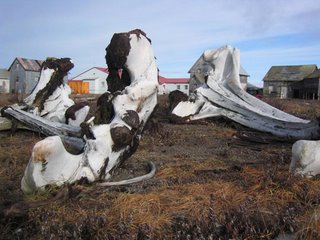
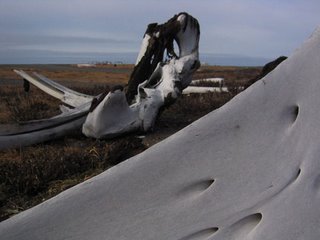
These Bowhead wahel jaw bones are displayed from an old harvest on the west beach. In one photo, you can see the red roof top of our teacher's housing in the background. There is a considerable difference between whales hunted by the Siberian Yupik peoples out here in the Bering Sea zone those hunted by other aboriginal groups across the bering Straits that rely on the smaller Gray whale. The huge bowhead whale (weighing from 30 to 100 tons or more) provides more products than the Gray whale (commonly weighing up to 20-25 tons) and is of greater nutritional value. The Mantak (whale meat and blubber eaten together) of the Bowhead has a nice, sweat taste, especially if a young whale (inutuk). Inutuk can be stored raw for up to 20-25 days, while the Mantak of the Gray whale is unfit for consumption after 10-12 days (the skin separates from the fat). The meat of the Bowhead is softer and more tender. This meat, like walrus meat is soured and kept in meat pits for the winter whereas the Gray whale meat does not get sour, it rots. It can be stored, bolied or if there is need for long-term storage it has to be frozen
Whaling Boats on the West Beach
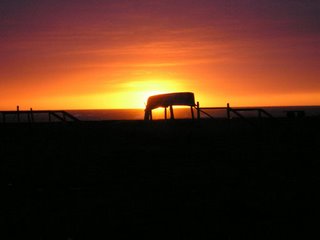
Gambell still depends upon traditional subsistence acivities as a way of life. Walrus and seal hunting produce some of the most significant harvests for the village. Whaling, though, is the fulcrum upon which all of Gambell's subsistence economy rests. the bowhead whale which is primarily harvested out here, can reach over 100 tons and provide the village with food and resources for years. Last year the village missed its annual bowhead harvest, so everyone is eagerly awaiting the big catch this coming spring when bowheads migrate through the region. The Boat in the foreground of this increadible Bering Sea sunset, is one of several traditional walrus skin boats used in the whalehunt. These skin boats are all mounted on large lacks on the west beach just a few hundred yards from teacher housing.
On the Way to Seal Camp


It's early September and I am off to Wesley's seal camp. Wesley has been in Gambell all of his life. Wesley's in the middle and Brad, another teacher, is on the right. Wesley says that Spetember's a good time to hunt the bearded seal because the prevailing winds blow from the west and hit the shore. He says that this helps bring in a seal that's been shot without going out in a boat. I was told the bearded seal can get up to 800 pounds out here. Wesley's camp is about 8 miles south of Gambell on the tundra. The next picture shows the shelter at seal camp. Our seal hunting expidetion was cut short, unfortunately, because the four-wheeler developed mechanical problems and kept stalling on the tundra. At this time of year, the tundra in places is a muddy morasse and we just happened upon all of those places. By the time we reached the shelter(brad and myself walked most of the way with our gear so as not to load down the four-wheeler too much) we were too tired to head down to Wesley's seal blind, so we set up camp at the shelter and settled in for the night.
A view of Gambell
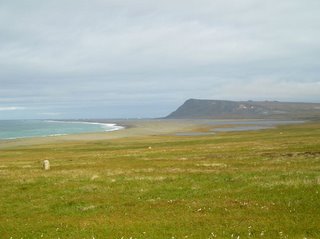
This is a shot of Gambell four miles south along the coast of Sivuqaq. Gambell is barley visiable to the west of the mountain in the picture. The "mountain" is really just a small plateau about 600 feet above level. Gambell is perched precipitously on the edge of the Bering Sea spread over a three three radius along a gravel spit. The west-facing aspect of the beach (where our housing is located) on the left of the picture, is constantly shifting and eroding from big waves and shore fast ice in the winter. This picture was taken in early September when I accompanied local freind on a seal hunt. I went with one other teacher on a trip that was designed as an overnighter at Wesley's seal camp.















